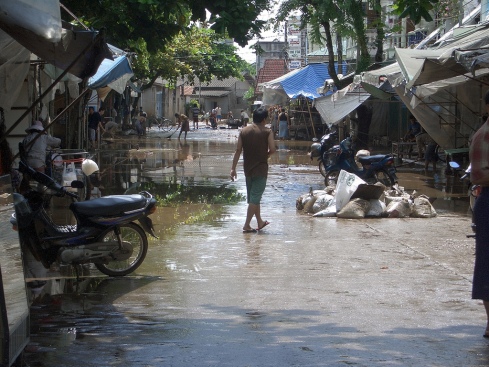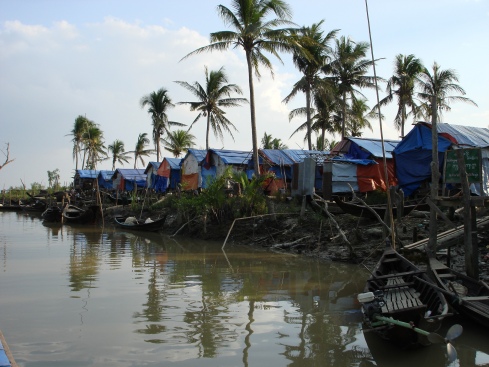
By PISA Program Assistant, Dr. Miriam Grinberg
Following Myanmar Ambassador Aung Lynn’s visit to the Elliott School of International Affairs on Monday, December 12, PISA provides critical background information on the country through our blog. Previously, we discussed the country’s challenges in natural resource governance and the continued consequences of the Cold War. This post concludes the series with a focus on the impact of sea level rise and climate change on Myanmar’s future.
In my previous post’s overview of the difficulties that Burmese policymakers face in managing and distributing natural resources equitably, I noted that Myanmar is well-known for its rich biodiversity and wealth of resources, such as natural gas and jade. As the country continues to undergo political and economic transformation – including the development of its energy and industry sectors, urban areas, and agricultural production – the sustainability of its new enterprises has increasingly come into question, not to mention their environmental impact. Combined with its geographical location (sandwiched between two of the world’s largest polluters, China and India), it is no wonder that the country was recently called the second most vulnerable in the world to the impacts of climate change.
Of these, the effects of rising sea level have some of the greatest potential for causing widespread devastation in the country. The estimated 0.5 meter rise, which is predicted to occur by 2100, could result in the Ayeyarwady Delta shoreline advancing by 10 km – a development which would significantly impact poorer, rural Burmese employed in the agricultural sector. This is because – as previously discussed in the cases of Vietnam and Indonesia – increasing sea level causes crop fields to become oversalinated, leading to declines in important exports, including rice. Myanmar can also anticipate more extreme weather events in the form of cyclones and flooding along the lines of 2008’s Cyclone Nargis, which left over 140,000 Burmese missing or dead in addition to causing untold property and ecological damage. It is only in the last 16 years, in fact, that cyclones have consistently made landfall along the coast — before 2000, they only did so once every three years.

These floods have led to a number of issues which threaten the livelihoods and safety of millions of Burmese. These include: groundwater contamination; the aforementioned saltwater intrusion into rice paddies; displacement; increased outbreaks of waterborne and vector-borne diseases, such as malaria and diarrhea; loss of coral reefs and mangroves; and damage to infrastructure. The last of these is a threat particularly to Myanmar’s growing hydropower industry, as its rivers will be vulnerable to increased droughts and floods alike and may overwhelm and erode dams, among other structures.
Recognizing the perils the country faces should climate change and sea level rise continue unabated, the government of Myanmar has undertaken a number of steps towards enhancing disaster preparedness as well as climate-smart development strategies. Since Nargis, for example, the government has put in place a Disaster Management Law and was thus much better-prepared for when Cyclone Mahasen struck in 2013, having evacuated over 100,000 people from the storm’s path before it came onshore. Myanmar also has a National Adaptation and Plan of Action which focuses on improving early warning systems and preserving the agricultural sector. PISA has also contributed to these ongoing efforts by establishing the Myanmar Advanced Leadership Institute on Climate Change (MALICC) in 2013 and 2015, which catalyzed problem-oriented and cross-disciplinary training for public officials and civil society leaders in Myanmar. Finally, there is the Myanmar Climate Change Alliance, an initiative jointly funded by the European Union, U.N.-Habitat and U.N. Environmental Program which holds numerous workshops and consultations with ministries in the Burmese government, civil society groups, and communities affected by climate change in order to craft effective policies to counter it.

Nonetheless, in a 2014 index by The Global Adaptation Institute, Myanmar ranked 163 out of 180 countries both in terms of its vulnerability to climate change and its readiness to improve resilience. This is in large part due to low adaptive capacity – the country has very little long-term domestic expertise on which to draw in this field – but coordination between government and non-governmental agencies is also still unstructured, with greater attention needed to address long-term risk reduction. PISA’s 2013 MALICC report likewise found that embedding advanced courses on climate change resilience within Myanmar’s higher education system will be crucial moving forward.
This kind of reduction entails wide-scale public awareness campaigns about the impacts of climate change, community training for disaster preparedness, improving drainage systems, and preserving as much as possible the country’s inland forests and marine environments, which provide natural protection against extreme weather events. What these suggestions highlight, therefore, is that there is no escaping this essential truth: that those natural resources which Myanmar is so reliant upon to ensure its continued development are the very same which it must take care to protect in order to ensure the safety and survival of its citizens.



One Response to “Climate Change and Sea Level Rise in Asia: Myanmar”